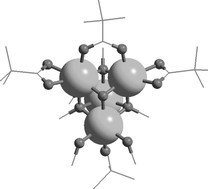Abstract of Publication No. 485
 Grégory Chaboussant, Reto Basler, Hans-Ulrich Güdel, Stefan Ochsenbein, Andrew Parkin, Simon Parsons, Gopalan Rajaraman,
Andreas Sieber, Andrew A. Smith, Grigore A. Timco and Richard E. P. Winpenny
Grégory Chaboussant, Reto Basler, Hans-Ulrich Güdel, Stefan Ochsenbein, Andrew Parkin, Simon Parsons, Gopalan Rajaraman,
Andreas Sieber, Andrew A. Smith, Grigore A. Timco and Richard E. P. Winpenny
Nickel pivalate complexes: structural variations and magnetic susceptibility and
inelastic neutron scattering studies
Dalton Trans. 2758-2766 (2004)
![]()
![]()
Abstract:
The synthesis and structural characterisation of three small
nickel(II) cages are reported, all stabilised by pivalate
ligands. The magnetic properties of the cages have been studied by a combination
of susceptibility measurements and inelastic neutron scattering. For a dinuclear
cage,
[Ni2(m-OH2)(O2CCMe3)4(HO2CCMe3)4] 1
the ground state is S = 2, with a ferromagnetic exchange interaction
between the Ni(II) centres of J = 0.32 meV and
DS=2 = –0.09 meV in the ground state. For a tetranuclear
heterocubane cage,
[Ni4(m3-OMe)4(O2CCMe3)4(MeOH)4] 2,
two ferromagnetic exchange interactions are found and an S = 4 ground
state observed. While the zero-field splitting of this state cannot be
determined unambigiously the most likely value is
DS=4 = –0.035 meV. For a tetranuclear nickel butterfly,
[Ni4(m3-OH)2(O2CCMe3)6(EtOH)6] 3,
three exchange interactions are required, two anti-ferromagnetic and one weakly
ferromagnetic; the resulting ground state is S = 0. The data enable us to
estimate the zero-field splitting of single Ni(II) ions involved
in the cage as Di = +1.0 meV. Both 1 and 2 are
therefore expected to be new single molecule magnets.